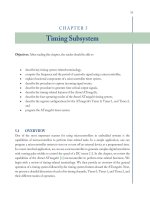Interrupt Subsystem
Bạn đang xem bản rút gọn của tài liệu. Xem và tải ngay bản đầy đủ của tài liệu tại đây (191.91 KB, 10 trang )
65
CHAPTER 4
Interrupt Subsystem
Objectives: After reading this chapter, the reader should be able to
•
understand the need of a microcontroller for interrupt capability,
•
describe the general microcontroller interrupt response procedure,
•
describe the ATmega16 interrupt features, and
•
properly configure and program an interrupt event for the ATmega16.
4.1 INTERRUPT THEORY
A microcontroller normally executes instructions in an orderly fetch--decode--execute sequence as
dictated by a user-written program as shown in Figure 4.1. However, the microcontroller must
be equipped to handle unscheduled, higher-priority events that might occur inside or outside the
microcontroller. To process such events, a microcontroller requires an interrupt system [1].
The interrupt systemonboard a microcontroller allows it to respond to higher-priority events.
These events may be planned, but we do not know when they will occur. When an interrupt event
occurs, the microcontroller will normally complete the instruction it is currently executing and then
transition program control to interrupt event specific tasks. These tasks, which resolve the interrupt
event, are organized into a function called an interrupt service routine (ISR). Each interrupt will
normally have its own interrupt specific ISR. Once the ISR is complete, the microcontroller will
resume processing where it left off before the interrupt event occurred.
4.2 ATmega16 INTERRUPT SYSTEM
The ATmega16 is equipped to handle a powerful and flexible complement of 21 interrupt sources.
Three of the interrupts originate from external interrupt sources, whereas the remaining 18
interrupts support the efficient operation of peripheral subsystems aboard the microcontroller. The
ATmega16 interrupt sources are shown in Figure 4.2. The interrupts are listed in descending order
of priority. As you can see, the RESET has the highest priority, followed by the external interrupt
request pins INT0 (pin 16) and INT1 (pin 17). The remaining interrupt sources are internal to the
ATmega16.
66 ATMEL AVR MICROCONTROLLER PRIMER: PROGRAMMING AND INTERFACING
Fetch
Decode
Execute
Interrupt
Service
Routine
FIGURE 4.1: Microcontroller interrupt response.
When an interrupt occurs, the microcontroller completes the current instruction, stores the
address of the next instruction on the stack, and starts executing instructions in the designated ISR
corresponding to the particular interrupt source. It also turns off the interrupt system to prevent
further interrupts while one is in progress. The execution of the ISR is performed by loading the
beginning address of the ISR specific for that interrupt into the program counter. The ISR will
then commence. Execution of the ISR continues until the return from interrupt instruction (reti)
is encountered. Program control then reverts back to the main program.
4.3 PROGRAMMING AN INTERRUPT
To program an interrupt, the user is responsible for the following actions:
•
Ensure the ISR for a specific interrupt is tied to the correct interrupt vector address, which
points to the starting address of the ISR.
INTERRUPT SUBSYSTEM 67
FIGURE 4.2: Atmel AVR ATmega16 Interrupts [2]. Figure used with permission of Atmel.
68 ATMEL AVR MICROCONTROLLER PRIMER: PROGRAMMING AND INTERFACING
•
Ensure the interrupt system has been globally enabled. This is accomplished with the
assembly language instruction SEI.
•
Ensure the specific interrupt subsystem has been locally enabled.
•
Ensure the registers associated with the specific interrupt have been configured correctly.
In the next two examples that follow, we illustrate how to accomplish these steps. We use the
ImageCraft ICC AVR compiler, which contains excellent support for interrupts. Other compilers
have similar features.
4.4 APPLICATION
In this section, we provide two representative samples of writing interrupts for the ATmega16.
We provide both an externally generated interrupt event and also one generated from within the
microcontroller. The ImageCraft ICC AVR compiler uses the following syntax to link an ISR to
the correct interrupt vector address:
#pragma interrupt_handler timer_handler:4
void timer_handler(void)
{
:
:
}
As you can see, the #pragma with the reserved word interrupt
handler is used to communicate
to the compiler that the routine name that follows is an ISR. The number that follows the ISR
name corresponds to the interrupt vector number in Figure 4.2. The ISR is then written like any
other function. It is important that the ISR name used in the #pragma instruction matches the
name of the ISR in the function body. Because the compiler knows the function is an ISR, it will
automatically place the RETI instruction at the end of the ISR when the corresponding assembly
language is generated.
4.4.1 External Interrupts
The external interrupts INT0 (pin 16), INT1 (pin 17), and INT2 (pin 3) trigger an interrupt within
the ATmega16 when an external event of user-specified characteristics occurs at the pin associated
with the specific interrupt. Interrupts INT0 and INT1 may be triggered with a level or an edge
INTERRUPT SUBSYSTEM 69
signal, whereas interrupt INT2 is edge-triggered only. The specific settings for each interrupt is
provided in Figure 4.3.
Provided below is the code snapshot to configure an interrupt for INT0. In this specific
example, an interrupt will occur when a positive edge transition occurs on the ATmega16 INT0
external interrupt pin.
MCU Control Register - MCUCR
70
70
MCU Control and Status Register - MCUCSR
ISC2
INT2
0: falling edge
1: rising edge
70
General Interrupt Control Register - GICR
INT1 INT0 INT2
0: interrupt disabled
1: interrupt enabled
ISC11 ISC10 ISC01 ISC00
INT1
00: low level
01: logic change
10: falling edge
11: rising edge
INT0
00: low level
01: logic change
10: falling edge
11: rising edge
70
General Interrupt Flag Register - GIFR
INTF1 INTF0
INTF2
Notes:
- INTFx flag sets when corresponding interrupt occurs.
- INTFx flag reset by executing ISR or writing logic one to flag.
FIGURE 4.3: Interrupt INT0, INT1, and INT2 registers.









